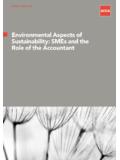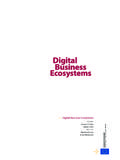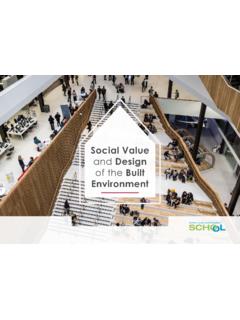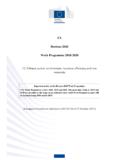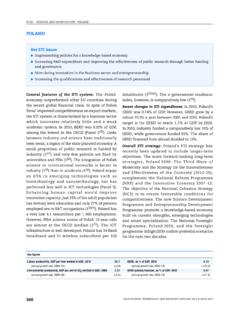Transcription of Food and Agriculture Organization of the United …
1 Business Models for Small Farmers and SME s APRIL 2008 food and Agriculture Organization of the United Nations ALL ACP AGRICULTURAL COMMODITIES PROGRAMME 2 Background This paper outlines the rationale behind the approach that FAO will adopt when supporting small farmer groups, producer organizations, and local service providers under the EU-ACP programme. The goal of FAO interventions, under this area of support, will be to strengthen small farmer market linkage capabilities, focussing on activities that build rural capacity and skills, stimulate value chain dialogue among actors, and facilitate access to finance and agro-enterprise services.
2 It will do this by working with the service providers most appropriate for guiding farmer groups and producer organizations on agro-enterprise functions. By adopting this approach FAO assistance will address the needs of the Programme s core beneficiaries, while simultaneously, strengthening the sustainability of local agro-enterprise service provision. This paper was written by Bill Vorley, Mark Lundy and James MacGregor under the guidance of Doyle Baker (FAO) for the Global Agro-Industries Forum, India, April 2008 ( ) 3 Abstract Small farmers and SMEs are increasingly tied to markets and agro-industries through business linkages and alliances with each other and with other value chain stakeholders.
3 There are many models of business linkages, some driven by producers, some by buyers and some supported by intermediaries including NGOs. The business model critically impacts on how value is created, captured or shared by farmers, SMEs and other chain actors. It is therefore important to establish inclusive, equitable and sustainable business models for farmers and SMEs. Factors which influence sustained and equitable inclusion of smaller scale farmers and SMEs are producer Organization , market coordination and intermediation, business support and financial services, buyer behaviour, and enabling policies and infrastructure.
4 Introduction Agrifood markets are in an unprecedented state of flux, with domestic markets undergoing rapid but uneven modernization. Market modernization offers increased economic opportunities for producers, small and medium-sized enterprises (SMEs), and other actors in the value chain, but there are also risks of local producers and domestic businesses being bypassed, or failing to meet costly market entry requirements which favour the better-resourced. If the Millennium Development Goals (MDGs) are to be even partially met by 2015, then market modernization and restructuring has to deliver a growth and equity win-win.
5 There is a growing body of experience showing that win-win outcomes are possible through commercially viable business models ways of creating value within a market network of producers, suppliers and consumers which involve small farmers and SMEs. These business models for small farmers and SMEs must deliver essential services to producers and ensure reliable supply to buyers, while also addressing the high transaction costs and risks that buyers face when purchasing from large numbers of fragmented, cash-strapped small farmers and SMEs.
6 This brief gives an overview of lessons learned about business models for including small farmers and SMEs in modernizing markets and agro-industries. What do we know about the main market and agro-industry changes going on? Policies of privatization, liberalization and accession to the WTO or EU in the 1980s to 2000s were followed by a wave of investments by food manufacturers and retailers. Combined with rising urbanization and changes in consumer preferences and purchasing power, these have led to a growth of modern food processing and retailing which often have requirements or industry standards for quality and safety built on traceability and certification.
7 Conformity with labour and environmental standards may also be required, with compliance costs proportionately much higher for smallholders. To achieve the multiple objectives of quality, safety and consumer assurance, reliability of supply, lower prices and sustainability, the business models of modern processors and retailers are being built on collaboration, co-investment and knowledge sharing between producers, suppliers, processors and retailers. Ultimately, the extent of collaboration and co-investment depends on the nature of the product (perishable, differentiated or branded product, or bulk commodity) and the nature of the end buyer (branded retailer, wholesale, etc.)
8 , but there is a general trend in most sectors and locations towards increased collaboration and co-investment among chain participants. The most collaborative supply chains are for perishable commodities such as fresh vegetables, and certified products such as organic or Freetrade coffee. Empirical research shows that modern market channels are not inherently exclusionary to small-scale farms. However, buyers generally seek out larger suppliers and also seek out areas that are already favoured by agribusiness, such as zones involved in export production.
9 Proactive initiatives and innovative business models are needed to create the incentives and conditions for sustained inclusion of small farmers and SMEs. What models have emerged for linking farmers to agro-industries and changing markets? The cornerstone of all business models for inclusion of small farmers is Organization of the farmers to reduce the costs faced by private companies. Private companies often prefer to work with organized farmers rather than individuals, despite the increased bargaining power that groups can enjoy, to overcome problems such as dispersion of producers, diseconomies of scale, poor access to information, technology and finance, inconsistent volume and quality, lack of traceability, and management of risk.
10 Producers may be organised by producers themselves, by the companies buying from the producers, or by an intermediary such as an NGO. 4 Producer Organization models such as co-operatives are established to provide members with economic benefits in terms of access to dynamic markets. These differ from social organizations in their entrepreneurial focus, and may build on existing informal networks of farmers and traders as well as inputs and support from buyers or other chain actors. Models that are driven and owned by small-scale producers like Cuatro Pinos in Guatemala allow producers to market collectively despite widely differing farm assets.










